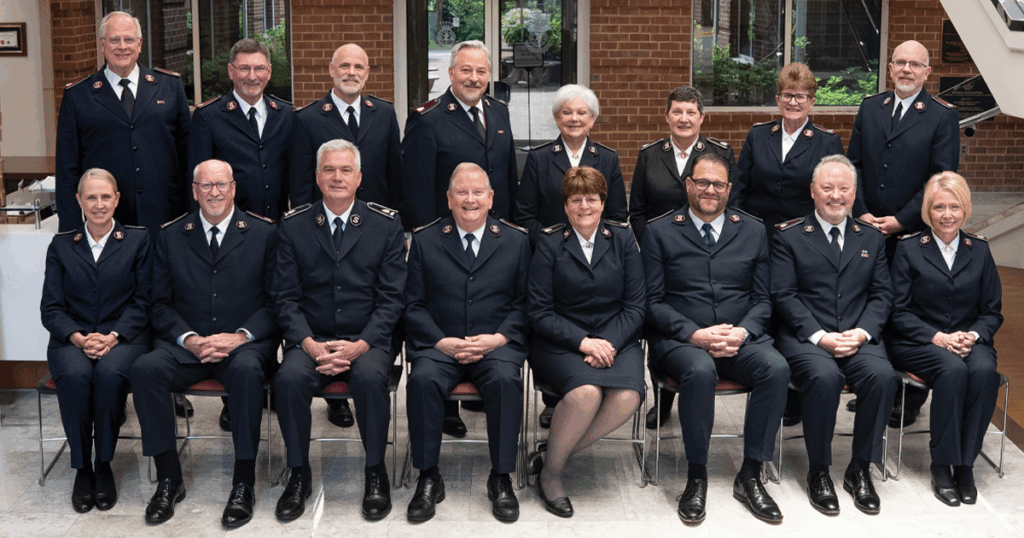Who is in Charge of The Salvation Army?
"Our structure is shaped by our unique history."
The Salvation Army has a unique and well-defined leadership structure. Above all, the Army acknowledges God as our ultimate authority. This truth is reflected in our doctrinal statements, foundational documents and mission statement. To ensure that this aim is upheld, we rely on a human leadership structure grounded in prayerful obedience. Those appointed to lead regard their responsibilities as a divine calling to be God’s representatives and servants to those they lead.
Our structure is shaped by our unique history. Influenced by our quasi-military structure, The Salvation Army uses a traditional hierarchal model. The primary leader holds the rank of General and is the international leader of The Salvation Army. He or she is elected by a High Council which consists of all senior officers from International Headquarters and territorial leaders.
Our structure may appear complicated but essentially there are only six steps from a soldier in a local corps/church to the General. A soldier is accountable to their local corps officer who is in turn supervised by their divisional commander, an officer appointed to oversee the functions of assigned corps within a specified region. Divisional commanders report to a territorial commander. In the United States there are four territories dividing the country into South, East, West and Central geographical segments. The United States also has a National Commander to coordinate and supervise services conducted in multiple territories. Within this basic hierarchy there are other subsets of leadership as each designated command could have appointed regional commanders and section leaders (often called secretaries) for various management aspects, such as program, youth work, personnel or business.
In every territory, officers receive the same allowance (income) except for minor differences reflecting factors like their number of dependents, rank or position. For example, in the United States allowances are adjusted up and down based on the number of dependents currently in the officer’s household. Modest housing is also provided for officer use but while the size and type of housing is regulated, their applied value varies based on location. Officers also receive modest pay increases for years of service. Overall, this means that a national or territorial commander (equivalent to a CEO) receives relatively the same base allowance and lives in a very similar residence to any other officer in The Salvation Army with similar years of service and household size.
The basic hierarchal structure isn’t the whole answer to this question, because leadership means more than just people who fill positions. The Salvation Army has many other avenues of decision making and for receiving advise. There are policies and procedures, which in our military structure are called “Orders & Regulations,” as well as established finance minutes which govern our day-to-day business. Local level leadership is held accountable by corps councils (a group of designated soldiers), as well as advisory boards (groups of local business and community leaders with an interest and investment in the organization). At the divisional level decisions are made through a divisional finance board or executive council made up of key officers and employees. Many divisions also have other committees to oversee specific aspects of ministry, such as ensuring child safety, reviewing proposed program changes, and evaluating and maintaining sound business practices. Territories have executive cabinets of senior officers and key employees as well as corresponding committees to meet the needs of the divisions they supervise. Each United States territory also provides legal counsel and maintains the requirements for tax exemption for their respective territory. Decisions about where officers are transferred and some aspects about how local units are resourced are made at the territorial level, with input from divisional leadership. Additional input and accountability are also received through established territorial forum groups, for officers and soldiers, to which representatives are appointed.
National Headquarters provides strategic leadership and leadership and coordination on matters of national interest. It also plays a role in fundraising, public relations, and ensuring consistent standards and practices. This is done through providing training and resources, representing The Salvation Army’s interests on national policy issues related to social welfare and human rights, and working with the international Salvation Army to share best practices and coordinate efforts on a global scale. National Headquarters also organizes and supports national leadership groups. Such as the Commissioner’s Conference, made up of all four American territorial commanders and chief secretaries, the National Advisory Board, and other national councils, committees and ad-hoc groups.
This has been a long answer to what seems like a simple question. When we think about who is in charge of any of us, Proverbs 16:9 (NIV) reminds us that “In their hearts humans plan their course, but the Lord establishes their steps.” The Salvation Army exists as a God-driven entity to share His love with a world that desperately needs it. He continues to establish our steps as an multi-faceted international organization, and we pray that in all our human plans, we continue to take the right steps so that He is always glorified.







